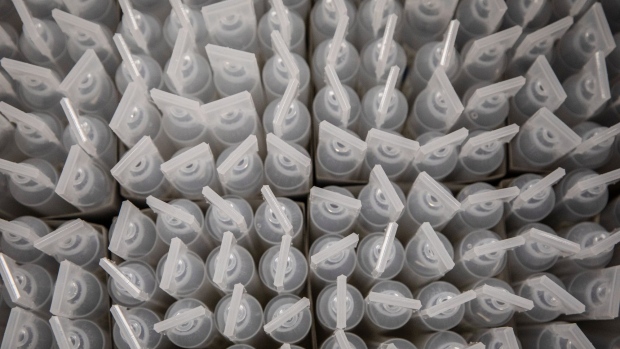Mar 4, 2022
Medical Saline Shortage Hits U.S. Hospitals Reeling From Omicron
, Bloomberg News

(Bloomberg) -- A staple of standard medical care is in short supply in the U.S. due to the most recent wave of the Covid-19 pandemic, and the war in Ukraine could make matters worse.
Saline solution is used in hospitals for everything from reconstituting drugs to flushing intravenous lines to rehydrating patients. It is a routine but critically important part of taking care of cancer patients, kids suffering from the flu, or people who wind up in the hospital because of an accident. Even a small hospital can use saline thousands of times a day.
But a confluence of factors, including supply-chain bottlenecks, high demand caused by the influx of omicron patients into hospitals, and virus-related worker scarcity have made these fundamental products harder to find. Saline vials and bags of all sizes are in shortage in the U.S., according to the Food and Drug Administration. Manufacturers say they are working hard to meet demand, and new production facilities are coming online.
The squeeze has deep roots, connected in part to the effort to get Americans vaccinated against Covid-19, but saline shortages are a familiar problem. Supply crises have emerged before, notably in the aftermath of Hurricane Maria in 2017, raising questions about whether producers could have done more to foresee potential snags.
For now, care providers are having to adapt on the fly. Children’s Mercy Kansas City, for example, has been able to get only about 70% of the saline it normally needs, even as cold weather sends more kids with respiratory viruses to the Missouri-based pediatric medical center, said pharmacy head Bethany Baker. Hospitals workers have struggled because they’re used to treating kids with small vials and bags -- the first saline products to run out.
“Smaller kids, smaller veins,” Baker said. “Everything small kind of fell off the table for us.”
Pharmacists and saline makers said they expect the issues to ease as the omicron surge abates, but more supply issues could arise in the longer term from the war in Ukraine. Health-care group purchasing organization Premier Inc. said Tuesday that disruptions to oil and natural-gas output in Eastern Europe or Russia could affect the global supply and pricing of plastics. Those materials are needed to make saline bags and syringes to administer the fluid.
Making Do
Amid coping with pandemic chaos, long-standing financial pressures and staffing shortages of their own, hospitals are now devoting time and energy to conserving and preparing saline products. Supplies have taken their biggest hit since 2017, when Hurricane Maria disabled a major plant in Puerto Rico, said Eric Tichy, who manages the pharmacy supply chain for the Mayo Clinic, with some 40 pharmacies in in its U.S. network.
“It’s been pretty severe,” Tichy said. “We’ve kind of had to make do with the things we have available.”
Among companies that suffered most from the 2017 storm was Baxter International Inc., the largest supplier of saline bags. Now, Baxter is doing everything possible to maximize production and expedite shipping during the current shortage, said Lauren Russ, a spokeswoman.
Saline-maker Fresenius SE’s manufacturing sites are running at full capacity, making and releasing as much product as possible, said Leif Heussen, a spokesman. B. Braun SE makes saline in California and just got regulatory approval for a factory in Florida that began shipping products Feb. 28, said Allison Longenhagen, a spokeswoman. ICU Medical Inc., another saline supplier, didn’t respond to a request for comment.
Cheap, small bags of saline are used throughout hospitals to infuse painkillers, antibiotics and chemotherapy drugs. One of the most common, important uses for saline is flushing drugs infused through intravenous lines. Nurses do this routinely to make sure all of the drug is pushed through the tubing into the patient’s body, leaving none in the line itself.
Flushing Lines
Nurses normally flush lines using a prefilled syringe of saline, but when those run out they have to improvise. Typically, a substitute would be to fill empty syringes from vials and small bags, but now those are also hard to find. A last resort is for pharmacists to use sterile rooms to fill multiple syringes from large bags of saline.
While it sounds like a small issue, the time investment can be enormous: Mercy’s Baker estimates that before the end of last year, when supply became tight, her hospital alone used 2,000 line flushes a day.
The trouble started when Pfizer Inc., one of the main suppliers of small vials of saline, needed to dedicate its containers to making Covid vaccine. Over time, as omicron illness and quarantines kept factory workers at home, the issues snowballed and small bags of saline, which nurses often use when they lack vials, ran low.
In an ominous example of how Covid’s demands on the medical system can ripple through vital operations, large bags of saline became scarce. They’re often a last resort to begin with because once opened outside a sterile room, they’re only good for about a hour, and the excess goes to waste.
No Wiggle Room
Pfizer has increased saline vial production over last year and hopes to see some recovery in supplies by spring, Julia Cohen, a spokeswoman, said.
Supply chain interruptions have impacted every industry during the pandemic. An aluminum shortfall has hurt supplies of tops for glass vials, Tichy said, and insufficient resin supplies have made plastic bag materials harder to find. Even paper needed to print informational package inserts that provide crucial information about drugs and other medical products has been in short supply, Fresenius’s Heussen said.
“It’s a very frustrating situation for staff that are already overworked and doing 100 other things,” said Erin Fox, a drug-shortage expert at University of Utah Health. “In the past, there was wiggle room, but everything is out now.”
©2022 Bloomberg L.P.


